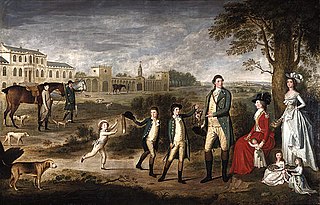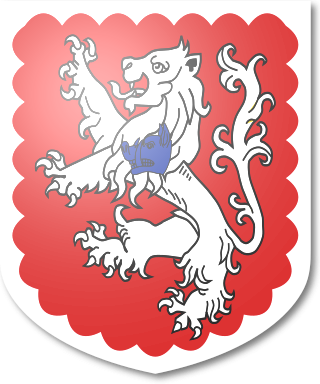Related Research Articles

Earl of Chichester is a title that has been created three times, twice in the Peerage of England and once in the Peerage of the United Kingdom. The current title was created in the Peerage of the United Kingdom in 1801 for Thomas Pelham, 2nd Baron Pelham of Stanmer.

Earl of Lonsdale is a title that has been created twice in British history, firstly in the Peerage of Great Britain in 1784, and then in the Peerage of the United Kingdom in 1807, both times for members of the Lowther family.

Earl of Cottenham, of Cottenham in the County of Cambridge, is a title in the Peerage of the United Kingdom. It was created in 1850 for the prominent lawyer and Whig politician Charles Pepys, 1st Baron Cottenham. ) He served as Lord Chancellor from 1836 to 1841 and from 1846 to 1850. Pepys had already been created Baron Cottenham, of Cottenham in the County of Cambridge, in 1836, and was made Viscount Crowhurst, of Crowhurst in the County of Surrey, at the same time he was given the earldom. These titles are also in the Peerage of the United Kingdom. The viscountcy is used as a courtesy title for the Earl's eldest son and heir apparent.

There have been three baronetcies created for persons with the surname Booth, one in the Baronetage of England and two in the Baronetage of the United Kingdom. The 1916 creation remains extant, the 1835 creation became extinct in 1896 and the 1611 baronetcy has been dormant since 1797. The senior line of the first creation was elevated to the peerage as Baron Delamer and Earl of Warrington.

There have been seven baronetcies created for members of the Lowther family, one in the Baronetage of Nova Scotia, two in the Baronetage of England, two in the Baronetage of Great Britain and two in the Baronetage of the United Kingdom. Two of the creations are extant as of 2008.
There have been four baronetcies created for persons with the surname Leslie, one in the Baronetage of Nova Scotia, one in the Baronetage of Ireland, one in the Baronetage of Great Britain and one in the Baronetage of the United Kingdom. Three of the creations are extant as of 2010.

There have been five baronetcies of the United Kingdom created for a person with the surname Erskine, two in the Baronetage of Nova Scotia, one in the Baronetage of Great Britain and two in the Baronetage of the United Kingdom. Two of the creations are extant as of 2010.

There have been twenty one baronetcies created for persons with the surname Williams, eight in the Baronetage of England, three in the Baronetage of Great Britain and ten in the Baronetage of the United Kingdom. Only six of the creations are extant as of 2017.
There have been three baronetcies held by people with the surname Lindsay, one in the Baronetage of Nova Scotia and two in the Baronetage of the United Kingdom. One creation is extant.
There have been two baronetcies created for persons with the surname Boulton, both in the Baronetage of the United Kingdom.
There have been two baronetcies created for members of the Morrison-Bell family, both in the Baronetage of the United Kingdom.

There have been nine baronetcies created for persons with the surname Cooper, one in the Baronetage of England, one in the Baronetage of Ireland and seven in the Baronetage of the United Kingdom.
There have been two baronetcies created for persons with the surname Holcroft, both in the Baronetage of the United Kingdom for members of the same family.
There have been seven baronetcies created for persons with the surname Edwards, three in the Baronetage of England and four in the Baronetage of the United Kingdom. Only one creation is extant as of 2007.
Three baronetcies were created for persons with the surname D'Oyly, two in the Baronetage of England and one in the Baronetage of the United Kingdom. One creation is extant as of 2008.

The Worsley family is an English family that is derived from Sir Elias de Workesley, a Norman knight who was a youth at the time of the Norman conquest. He later accompanied Duke Robert II of Normandy on the First Crusade and was buried at Rhodes.
There have been three Baronetcies created for the family of Walker, later known as Forestier-Walker. The original title was in the Baronetage of England and the other two in the Baronetage of the United Kingdom. The earliest and the latest are both extinct, but one baronetcy is still extant.

The Horton Baronetcy, of Chadderton in the County of Lancaster, was a title in the Baronetage of Great Britain. It was created on 22 January 1764 for William Horton, High Sheriff of Lancashire in 1764. The second Baronet was High Sheriff of Lancashire in 1775. The title became extinct on the death of the third Baronet in 1821.
There have been three baronetcies created for persons with the surname Cowan, all in the Baronetage of the United Kingdom. All three creations are extinct.
The Brabazon Baronetcy, of Newpark in the County of Mayo, was a title in the Baronetage of Ireland. It was created on 16 December 1797 for Anthony Brabazon. He was the eldest son and heir of George Brabazon, of New Park in County Mayo, fourth in descent from Sir Anthony Brabazon of Ballinasloe Castle, younger brother of Edward Brabazon, 1st Baron Ardee, ancestor of the Earls of Meath. His son, the second Baronet, represented County Mayo in Parliament. The title became extinct on his death in 1840. Brabazon Park was eventually inherited by Hugh Brabazon Higgins, only son of Luke Higgins of Castlebar by his second wife Catherine, sister of Sir Anthony Brabazon. He was a Captain in the 15th Hussars, and adopted the surname of Brabazon by royal licence of 15 September 1852. He died in 1864, leaving issue.
References
- ↑ "No. 10441". The London Gazette . 11 August 1764. p. 1.
- ↑ Burke, John; Burke, Sir Bernard (1841). A Genealogical and Heraldic History of the Extinct and Dormant Baronetcies of England, Ireland and Scotland (2nd ed.). Scott, Webster, and Geary. p. 176.
- ↑ "No. 27858". The London Gazette . 28 November 1905. p. 8538.
- ↑ Rayner, Simeon; Smith, William (1887). The History & Antiquities of Pudsey. p. 121.
- ↑ "No. 41136". The London Gazette . 26 July 1957. p. 4428.
- ↑ "No. 27858". The London Gazette . 28 November 1905. p. 8535.